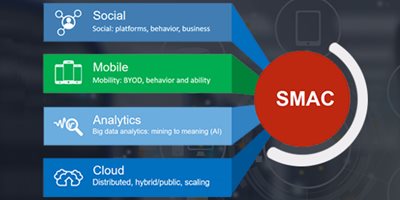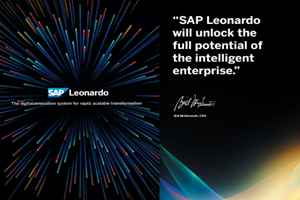Say Goodbye to the ECM Era & Embrace the Sixth Era
I have always thought that no matter what, ECM would retain its invisible position more in the  background as a supporting service for other business applications because the golden age of high growth for ECM has ended. However the other day, I stumbled upon a report written by John Mancini, President, AIIM, which is a non-profit industry association with more than 80,000 community members, and it made me ponder what if I have actually been very optimistic by my statement on the ECM space, as the report claims that there have been five distinct technology waves or eras in dealing with the challenge of managing the people, process, and information intersection, and the ECM era was the last one of them as now, we are making a transition to this sixth era (still to be defined) dominated by Mobile, Analytics, Cloud, and Collaborative (MACC) technologies.
background as a supporting service for other business applications because the golden age of high growth for ECM has ended. However the other day, I stumbled upon a report written by John Mancini, President, AIIM, which is a non-profit industry association with more than 80,000 community members, and it made me ponder what if I have actually been very optimistic by my statement on the ECM space, as the report claims that there have been five distinct technology waves or eras in dealing with the challenge of managing the people, process, and information intersection, and the ECM era was the last one of them as now, we are making a transition to this sixth era (still to be defined) dominated by Mobile, Analytics, Cloud, and Collaborative (MACC) technologies.
In the report, Mancini made a great point saying: “Organizations have dealt with the challenges associated with the intersection of people, processes, and information through a series of technology waves.” He also briefly identified these five distinct technology waves, Paper, Micrographics, ERP, Document Management/Workflow, and ECM, respectively. Even though it struggles for an identity and a label, to manage the intersection of people, process, and information, a sixth era is underway, according to Mancini. In this article, we will take a closer look at what is making the next wave of technology.
I agree that the challenge associated with the intersection of people, processes, and information has been driving the industry to go through a series of technology waves for decades. The main reason is that there is always an innovation to start a ripple effect and those ripples eventually make a wave that all ECM vendors need to ride through. This time, the first ripple came with the introduction of the iPhone in 2007 as it marked the mobile revolution which has entirely changed users’ expectations of the web and the digital experiences it generates. With the rising adoption of cloud computing, collaborative apps, and advanced analytics, the ripple effect picked up speed. Since those ripples turned into a wave, there hasn’t been a day that goes by without reading an announcement saying another vendor has made new enhancements to its user interface due to the emerging demand for a more customer-like experience.
In recognition of a new era, AIIM inquired with 56 senior information management executives from Europe and North America about what’s ahead in terms of content and information management. Here are some common predictions that will become a reality by 2020, according to AIIM:
-
New approaches to privacy and security
-
Ubiquitous broadband connectivity
-
Bottom-up rather than top-down innovation
-
Lots more virtual and distributed work
-
A shortage of “connective” and analytic skills
-
An OPEX vs. CAPEX procurement model
-
Increased regulation of the cloud by national governments.
Considering the news we have been reporting on here at CMS-connected, it is safe to say that extensibility and integration with external systems are imperative for any ECM vendor. One of the primary reasons why the ECM era has come to an end is that a single monolithic approach created silos and failed at achieving to help enterprises with their primary overarching business objectives such as cost and time efficiency, maintenance and spearing of business knowledge, and regulatory compliance and risk management. With the birth of a multi-repository approach, enterprises started breaking down content silos.
Why is it so important to break down content silos, you may ask? I asked the same question to Chris McLaughlin, CMO at Nuxeo, and here’s what he had to say: “Many organizations truly struggle to get a complete view of the information that they use to run their businesses on a daily basis. This is particularly true of unstructured information – or what we like to refer to as content. According to the most recent Gartner estimates, more than 80% of the information in the enterprise is unstructured and the amount of this information is growing at amazing rates. So, if this unstructured information, or content, is spread across any number of siloed systems, how can any organization properly manage its most valuable asset, its information?” He also added that today, even in Government, both federal and local agencies are looking to bridge siloes to provide better services to their constituents.
Chris McLaughlin, CMO at Nuxeo, and here’s what he had to say: “Many organizations truly struggle to get a complete view of the information that they use to run their businesses on a daily basis. This is particularly true of unstructured information – or what we like to refer to as content. According to the most recent Gartner estimates, more than 80% of the information in the enterprise is unstructured and the amount of this information is growing at amazing rates. So, if this unstructured information, or content, is spread across any number of siloed systems, how can any organization properly manage its most valuable asset, its information?” He also added that today, even in Government, both federal and local agencies are looking to bridge siloes to provide better services to their constituents.
Many ECM vendors have long been hidden in a single repository world. However, to ride this new sixth wave, they are expected to have the content management capabilities to enable third-party and custom-made applications to interact with and consume content in the content repository. IBM’s Toby Bell, “We live in an era of information anarchy. If your teams are putting information into new silos rather than testing extension of systems which you’ve already invested in, there are business risks and technical problems. This is irresponsible to ignore.”
How are ECM Vendors Reacting to the New Era?
Gartner has projected that 40 percent of new enterprise applications implemented by service providers will include AI technologies by 2021. One of the most prominent drivers behind this fast-emerging trend is that enterprises are really looking for solutions that work end to end and the advanced technologies like artificial intelligence bridge the gaps on organizations’ digital transformation and innovation journeys. Given the explosion of enterprise AI products, many  ECM vendors are striving to thrive in this steep competition. Box, for instance, has successfully capitalized on the transition to cloud and mobile, and now, it is currently working on new features powered by artificial intelligence. "The first core principle is that we have to grow fast enough to capture this opportunity," stated Box CEO Aaron Levie when asked about their plans on embracing AI technologies in late June. Following that statement, the company announced a deepening relationship with Microsoft to co-sell its cloud content management platform with Azure to enterprise customers, and add Microsoft's machine learning and artificial intelligence services into its platform.
ECM vendors are striving to thrive in this steep competition. Box, for instance, has successfully capitalized on the transition to cloud and mobile, and now, it is currently working on new features powered by artificial intelligence. "The first core principle is that we have to grow fast enough to capture this opportunity," stated Box CEO Aaron Levie when asked about their plans on embracing AI technologies in late June. Following that statement, the company announced a deepening relationship with Microsoft to co-sell its cloud content management platform with Azure to enterprise customers, and add Microsoft's machine learning and artificial intelligence services into its platform.
M-Files has recently waded into the foray as it added more AI functionality to its platform through a partnership with ABBYY, an artificial intelligence (AI), text-scanning and optical character recognition software company.
SAP, on the other hand, rolled out a cloud service that can help ingest, process and make sense of the hordes of IoT data, called Leonardo, back in May. "SAP Leonardo brings a lot of our innovation technologies together and the approach we're taking is very much about how we help customers implement a system of innovation very rapidly," said David Jonker, SAP senior director of predictive analytics. In other words, the primary point of the platform is to help customers develop digital transformation projects with advanced technologies like IoT. As we previously reported, the findings a 451 Research survey revealed that 71% of enterprises are gathering data for IoT initiatives today. One of the most common impediments cited in the report was the lack of perceived business use cases thus vendors like SAP have been aiming to help enterprises, which are struggling to find their place in the IoT-enabled landscape, discover their business cases for this emerging technology.
of the hordes of IoT data, called Leonardo, back in May. "SAP Leonardo brings a lot of our innovation technologies together and the approach we're taking is very much about how we help customers implement a system of innovation very rapidly," said David Jonker, SAP senior director of predictive analytics. In other words, the primary point of the platform is to help customers develop digital transformation projects with advanced technologies like IoT. As we previously reported, the findings a 451 Research survey revealed that 71% of enterprises are gathering data for IoT initiatives today. One of the most common impediments cited in the report was the lack of perceived business use cases thus vendors like SAP have been aiming to help enterprises, which are struggling to find their place in the IoT-enabled landscape, discover their business cases for this emerging technology.
SDL, a content management, and language translation software, has recently made an  agreement with Xillio, a Netherlands-based specialist in the area of content migration and integration, to integrate Xillio software into its translation technology product line. During our media reporter Laura Myers’s interview with Thomas Labarthe, the EVP of Business and Corporate Development at SDL, he said: “SDL Managed Translation platform basically allows enterprises to submit, approve, and review their localization projects in a very user-friendly way. With the addition of Xillio, we can add all the shelved connectors straight to the platform which makes the process seamless.”
agreement with Xillio, a Netherlands-based specialist in the area of content migration and integration, to integrate Xillio software into its translation technology product line. During our media reporter Laura Myers’s interview with Thomas Labarthe, the EVP of Business and Corporate Development at SDL, he said: “SDL Managed Translation platform basically allows enterprises to submit, approve, and review their localization projects in a very user-friendly way. With the addition of Xillio, we can add all the shelved connectors straight to the platform which makes the process seamless.”
My POV
Moving forward, all ECM solutions should include an effective deployment of web content management, digital asset management and social collaboration platforms that make it easy to develop granular applications, minimizing/eliminating the need for code and incorporating analytics at the core. The ECM solutions that are easier to use, easier to integrate with core business process applications, and built for mobile and cloud from the ground up will survive through the sixth era.

Venus Tamturk
Venus is the Media Reporter for CMS-Connected, with one of her tasks to write thorough articles by creating the most up-to-date and engaging content using B2B digital marketing. She enjoys increasing brand equity and conversion through the strategic use of social media channels and integrated media marketing plans.